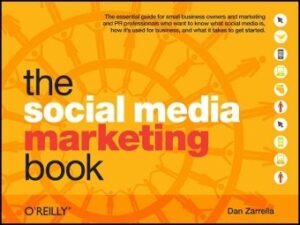| Book Name: | The Social Media Marketing Book by Dan Zarrella |
| Language: | English |
| Format: | |
| Free Download: | Available |
Download The Social Media Marketing Book by Dan Zarrella | PDF Free Download.
| Book Details : | |
|---|---|
| Language | English |
| Pages | 241 |
| Format | |
| Size | 7.09 MB |
The Social Media Marketing Book by Dan Zarrella

Social Media Marketing Contents
- Introduction
- Blogging
- Twitter and Microblogging
- Social Networking
- Media Sharing
- Social News and Bookmarking
- Ratings and Reviews
- Virtual Worlds
- Strategy, Tactics, and Practice
- Measurement.
Introduction to The Social Media Marketing PDF Book
Something strange is happening. Your advertising doesn’t work anymore, at least not like it used to. You used to be able to buy some TV time or put an ad in a newspaper, but nowadays everyone has TiVo or a DVR and gets their news online.
The conversations that took place under industrial broadcast media about your products happened in small groups, and their words disappeared as soon as they were spoken.
Now the conversations happen in front of millions of people, and they’re archived for years to come. Not only is your brand no longer the host, most of the time you’re not even a welcome guest. But it’s not all doom and gloom.
You don’t have to try to outspend the biggest companies anymore; now you can outsmart them with viral videos. You don’t have to spend thousands on sterile focus groups; you’ve got your market’s pulse at your fingertips with quick Twitter searches.
And you don’t have to do all the work yourself; the stuff your fans create will blow you and your competitors away.
More than 250 million people are active Facebook users. More than 346 million people read blogs, and 184 million people are bloggers themselves.
Twitter has more than 14 million registered users, and YouTube claims more than 100 million viewers per month.
More consumers are connected than ever before, and every second your company is not engaging them in social media is a wasted opportunity. So, get on board.
What Is Social Media Marketing?
Social media is best defined in the context of the previous industrial media paradigm. Traditional media, such as television, newspapers, radio, and magazines, are one-way, static broadcast technologies.
For instance, the magazine publisher is a large organization that distributes expensive content to consumers, while advertisers pay for the privilege of inserting their ads into that content.
Or you’re sitting down, watching your favorite sitcom, and suddenly you’re interrupted by commercials (luckily, you have a DVR, so you can fast-forward through them).
If you disagree with something you read in the newspaper, you can’t send the editorial staff instant feedback. And good luck connecting with your morning radio on-air personality.
New web technologies have made it easy for anyone to create and, most importantly distribute their own content.
A blog post, tweet, or YouTube video can be produced and viewed by millions virtually for free. Advertisers don’t have to pay publishers or distributors huge sums of money to embed their messages; now they can make their own interesting content that viewers will flock to.
Social media comes in many forms, but for our purposes, I’ll focus on the eight most popular: blogs, microblogs (Twitter), social networks (Facebook, LinkedIn), media-sharing sites (YouTube, Flickr), social bookmarking and voting sites (Digg, Reddit), review sites (Yelp), forums, and virtual worlds (Second Life).
Big Brands and Social Media
IBM owns more than 100 different blogs, a dozen islands in the virtual world of Second Life, several official Twitter accounts, and a popular forum called developerWorks.
It publishes a machinima series (a cartoon video made in Second Life) on YouTube, and several employees upload presentations to the media-sharing site SlideShare.
Dell has tapped the power of social media with its hugely popular IdeaStorm website, where users add ideas for new product lines and enhancements, vote them up or down, and comment on submissions.
Because of the site, Dell has started to ship computers with Linux installed and has added community support. Starbucks has also started to use this model to some success with its My Starbucks Idea site.
Burger King has made headlines time and time again with its innovative viral and social marketing campaigns, most recently with the “Whopper Sacrifice.”
The burger chain offered Facebook users free Figure 1-1. Burger King’s Facebook application was so successful that it had to be shut down.
Whopper coupon if they would “unfriend” 10 of their social network connections (see Figure 1-1) Cable giant Comcast has begun to salvage its tarnished reputation with a customer service outpost on Twitter led by Frank Eliason, Comcast’s “Director of Digital Care,” and his @comcastcares account.
Whenever someone tweets negatively about the company and that happens a lot Frank jumps in to offer whatever help he can.
This has led to some of the only positive press the brand has gotten in a long time. The shoe retailer Zappos, which most people already love, also has an awesome customer service presence on Twitter. U.S. President Barack Obama has been called the first social media president, and a strong argument could be made for the label.
As a candidate, he had one of the most popular Twitter accounts and Facebook pages, and his website contained a social media section where his supporters could create profiles and connect with each other.
The campaign was also present on YouTube, Flickr, LinkedIn, MySpace, and Second Life. Big brands have also faced embarrassment on social media.
One example is shown in Figure 1-2. In another example, two Domino’s Pizza employees posted a video to YouTube showing them defiling food that was to be delivered to customers.
That video was watched more than 1 million times in the first few days and was the subject of thousands of tweets.
Motrin released a commercial that offered its product as a solution to the pain women experience when carrying babies in harnesses attached to their torsos.
A day later, a small but vocal group of mommy bloggers had made the commercial the most discussed topic on Twitter, mostly expressing outrage.
These moms made critical videos and blog posts and called for a boycott of Motrin. Eventually, the company apologized and withdrew the commercial.
Small Business and Social Media
As indicated previously, social media is a great equalizer: big brands can be outsmarted without making huge investments, and small brands can make big names for themselves. Blendtec was a relatively unknown company selling $400 high-performance blenders.
After seeing CEO Tom Dickson testing the machines by blending two-by-fours, Marketing Director George Wright had a brilliant idea for a series of viral videos.
He started to blend everyday objects—glow sticks, iPhones, Rubik’s Cubes, and television remote controls—and posted the videos to media-sharing sites such as YouTube (see Figure 1-3).
The videos have now been watched more than 100 million times and have garnered the company a ton of press and buzz.
A small specialty baker in New Jersey, Pink Cake Box, leverages nearly every social media type to build a substantial brand.
Employees write a blog that features images and videos of their unique cakes. They post the photos to Flickr and the videos to the company’s YouTube channel. Pink Cake Box has more than 1,300 followers on Twitter and more than 1,400 fans on Facebook.
The software startup I work for, HubSpot, has invested a lot of energy in social media marketing with some success.
Our blog has more than 19,000 subscribers (fueled by appearances on Digg, Reddit, and StumbleUpon), our company Twitter account has more than 16,000 followers, our LinkedIn group has more than 34,000 members, and our Facebook page has more than 6,000 fans.
We’ve launched a marketing forum, and have a lot of fun making amusing (and sometimes serious) videos for YouTube.
Social Media and You
Whether you are part of a small, medium, or giant business, or are an individual entrepreneur, your customers are using social media, and there’s no reason you shouldn’t be, too.
It costs almost nothing, is easy to get started, and can have an enormous financial impact on your business. This book will teach you everything you need to know to pick the right tools and get started.
While writing this book, I spoke with some of the most brilliant social media pioneers, including people from Flickr, Yelp, Mashable, WebmasterWorld, Second Life, and Scout Labs.
They shared their wisdom on how you can and should be working with social media. Your customers and your competition are already involved in social media. Why aren’t you?
Download The Social Media Marketing Book PDF
Author(s): Dan Zarrella
Publisher: O’Reilly Media, Year: 2009
ISBN: 0596806604,9780596806606
Download The Social Media Marketing Book by Dan Zarrella in PDF Format For Free.
Related More Books
See More POST On : Engineering Books









![[PDF] Draw Buildings and Cities in 15 Minutes Draw Buildings and Cities in 15 Minutes pdf](https://www.freepdfbook.com/wp-content/uploads/2021/06/Draw-Buildings-and-Cities-in-15-Minutes-218x150.jpg)








![[PDF] Digital Image Processing An Algorithmic Introduction Using Java Digital Image Processing An Algorithmic Introduction Using Java](https://www.freepdfbook.com/wp-content/uploads/2022/06/Digital-Image-Processing-An-Algorithmic-Introduction-Using-Java.jpg)




![[PDF] 43 Years JEE ADVANCED + JEE MAIN Chapterwise & Topicwise Solved Papers 43 Years JEE ADVANCED (1978-2020) + JEE MAIN Chapterwise & Topicwise Solved Papers Physics PDF](https://www.freepdfbook.com/wp-content/uploads/2022/03/43-Years-JEE-ADVANCED-1978-2020.jpg)

![[PDF] Problems in Physical Chemistry for JEE (Main & Advanced) Problems in Physical Chemistry for JEE (Main & Advanced) Free PDF Book Download](https://www.freepdfbook.com/wp-content/uploads/2022/03/Problems-in-Physical-Chemistry-for-JEE-Main-Advanced.jpg)
![[PDF] Engineering Physics (McGraw Hill)](https://www.freepdfbook.com/wp-content/uploads/2021/05/bafc8c2685bb6823a9c56134f7fba5df.jpeg)

![[PDF] Engineering Chemistry By Shashi Chawla](https://www.freepdfbook.com/wp-content/uploads/2022/05/Theory-And-Practicals-of-Engineering-Chemistry-By-Shashi-Chawla-free-pdf-book.jpeg)
![[PDF] Chemistry: An Introduction to Organic, Inorganic & Physical Chemistry Chemistry: An Introduction to Organic, Inorganic & Physical Chemistry](https://www.freepdfbook.com/wp-content/uploads/2022/04/Chemistry-An-Introduction-to-Organic-Inorganic-Physical-Chemistry.jpg)
![[PDF] Essentials of Physical Chemistry Essentials of Physical Chemistry Free PDF Book by Bahl](https://www.freepdfbook.com/wp-content/uploads/2022/04/Essentials-of-Physical-Chemistry-bahl.jpg)
![[PDF] Biological control of plant-parasitic nematodes: soil ecosystem management in sustainable agriculture Biological control of plant-parasitic nematodes: soil ecosystem management in sustainable agriculture](https://www.freepdfbook.com/wp-content/uploads/2022/05/Biological-control-of-plant-parasitic-nematodes-soil-ecosystem-management-in-sustainable-agriculture.jpg)
![[PDF] Human Anatomy: Color Atlas and Textbook Human Anatomy: Color Atlas and Textbook Free PDF Book](https://www.freepdfbook.com/wp-content/uploads/2022/05/Human-Anatomy-Color-Atlas-and-Textbook.jpg)
![[PDF] Concepts of Biology Book [Free Download]](https://www.freepdfbook.com/wp-content/uploads/2022/05/Concepts-of-Biology.jpg)
![[PDF] Essentials of Biology [Free Download] Essentials of Biology Free PDF BOok Download](https://www.freepdfbook.com/wp-content/uploads/2022/05/Essentials-of-Biology-Free-PDF-Book-Downlaod.jpg)
![[PDF] Human Biology Book [Free Download]](https://www.freepdfbook.com/wp-content/uploads/2022/05/PDF-Human-Biology-Book-Free-Download.jpg)


